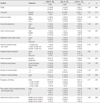Abstract
Purpose
This study examined the effectiveness of an Adolescent Motivational Interviewing Cessation program on smoking cessation change. The study was done with a nonequivalent control group pretest-posttest design.
Methods
The participants were 39 high school students from G city, who were in school from September 1 to October 30, 2009. The students were assigned to the experimental group (20) and participated in the motivational interviewing cessation program or to the control group (19) who did not participate. Data analyses involved χ2-test, independent t-test, Repeated Measures ANOVA, and utilized the SPSS program.
Figures and Tables
References
1. Byeon Y.S., Lee H.S. Relation of the blood pressure, lipids and body mass index by smoking status among adolescents. Journal of Korean Academy of Nursing. 2007. 37:1020–1026.
2. Chang S.O., Kim E.J., Kil S.Y., Seomun G.A., Lee S.J. Influential variables on intention and action to quit smoking between adoles cent smokers and adult smokers-Based on the transtheoretical model. Journal of Korean Academy of Nursing. 2005. 35:1410–1419.
3. DiClemente C.C., Prochaska J.O., Fairhurst S.K., Velicer W.F., Velasquez M.M., Rossi J.S. The process of smoking cessation: An analysis of precontemplation, contemplation, and preparation stages of change. Journal of Consulting and Clinical Psychology. 1991. 59:295–304. http://dx.doi.org/10.1037/0022-006X.59.2.295.
4. Erol S., Erdogan S. Application of a stage based motivational interviewing approach to adolescent smoking cessation: The transtheoretical model-based study. Patient Education and Counseling. 2008. 72:42–48.
5. Faul F., Erdfelder E., Lang A.G., Buchner A. G* Power 3: A flexible statistical power analysis program for the social, behavioral, and biomedical sciences. Behavior Research Methods. 2007. 39:175–191.
6. Hyun H.J., Ahn H.Y. An analysis of the research on effect of smoking cessation intervention. Journal of Korean Academy of Community Health Nursing. 2008. 19:469–477.
7. Jeong L.S., Youn B.B., Pi S.Y., Kang Y.J., Lee S.H. Smoking status and nicotine dependency of general high school students in Seoul. Journal of the Korean Academy of Family Medicine. 1996. 17:425–437.
8. Kim H.O., Jeon M.S. The relationship between smoking, drinking and the mental health in adolescents. Journal of Korean Academy of Public Health Nursing. 2007. 21:217–229.
9. Kim S.Y., Seo M.A., Nam G.A., Lee H.H., Park J.H. Development of school-based smoking cessation program for Korean smoking adolescents. Journal of Korean Academy of Psychiatric and Mental Health Nursing. 2002. 11:462–473.
10. Kim Y.K., Park I.H., Park J.S. Meta-analysis of effects on adolescent smoking cessation programs in Korea. Journal of Korean Academy of Nursing. 2008. 38:204–216.
11. Kohler C.L., Schoenberger Y.M., Tseng T.S., Ross L. Correlates of transitions in stage of change for quitting among adolescent smokers. Addictive Behaviors. 2008. 33:1615–1618.
12. Korea Centers for Disease Control & Prevention. 5th youth health behavior research online. 2010. Seoul: Korea Centers for Disease Control & Prevention;(ISSN 2005-2456).
13. Lawendowski L.A. A motivational intervention for adolescent smokers. Preventive Medicine. 1998. 27:A39–A46.
14. Lee C., Ko B.S., Lee M.S., Lee M.Y. Effect of attitude of parents and school on smoking status in high school students in a small city. Journal of the Korean Academy of Family Medicine. 2006. 27:278–287.
15. Lee H.S. A study on effective of vocational high school students' smoking cessation program operation: Focused on the transtheoretical model. Journal of Korea Community Health Nursing Academic Society. 2004. 18:205–217.
16. Lim E.S., Lee C.Y., Lee Y.J., Kim J.A. Effects of "5&6 smoking cessation program" on perception, behavior, and physiology of high school smokers. Journal of Korean Society for Health Education and Promotion. 2007. 24(4):115–130.
17. Lim Y.S., Lee J.H., Kim S.I., Ham J.S. Adolescent smoking behavior: Personality, motivation, nicotine dependence. Korean Journal of Youth Studies. 2003. 10:461–479.
18. Miller W.R.
S.H. Jo
S.K Sin
. Enhancing motivation for change in substance abuse treatment. 2007. U.S. Department of Health and Human Services;(Original work published 1999).
19. Miller W.R, Rollink S.
S.H. Jo
S.K Sin
. Motivational interviewing: Preparing people for change. 2006. New York, NY: The Guilford press;(Original work published 2002).
20. Pallonen U.E., Prochaska J.O., Velicer W.F., Prokhorov A.V., Smith N.F. Stages of acquisition and cessation for adolescent smoking: An empirical integration. Addictive Behaviors. 1998. 23:303–324.
21. Park N.H. Predictors of stage of change for smoking cessation among adolescents utilizing the transtheoretical model. 2002. Busan: Pusan National University;Unpublished doctoral dissertation.
22. Plummer B.A., Velicer W.F., Redding C.A., Prochaska J.O., Rossi J.S., Pallonen U.E., et al. Stage of change, decisional balance, and temptations for smoking: Measurement and validation in a large, school-based population of adolescents. Addictive Behaviors. 2001. 26:551–571.
23. Prokhorov A.V., Pallonen U.E., Fava J.L., Ding L., Niaura R. Measuring nicotine dependence among high-risk adolescent smokers. Addictive Behaviors. 1996. 21:117–127.
24. Slesnick N., Meyers R.J., Meade M., Segelken D.H. Bleak and hopeless no more. Engagement of reluctant substance-abusing runaway youth and their families. Journal of Substance Abuse Treatment. 2000. 19:215–222.
25. Velicer W.F., DiClemente C.C., Prochaska J.O., Brandenburg N. Decisional balance measure for assessing and predicting smokingstatus. Journal of Personality and Social Psychology. 1985. 48:1279–1289.
26. Velicer W.F., DiClemente C.C., Rossi J.S., Prochaska J.O. Relapse situations and self-efficacy: An integrative model. Addictive behaviors. 1990. 15:271–283.




 PDF
PDF ePub
ePub Citation
Citation Print
Print







 XML Download
XML Download